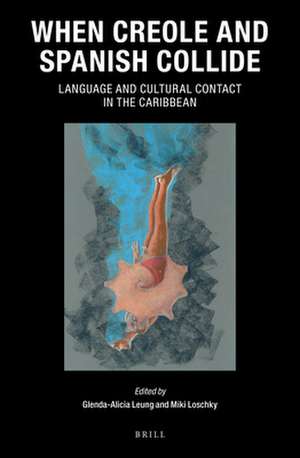When Creole and Spanish Collide: Language and Cultural Contact in the Caribbean: Caribbean Series, cartea 39
Glenda-Alicia Leung, Miki Loschkyen Limba Engleză Hardback – 11 mai 2021
Preț: 640.08 lei
Preț vechi: 780.58 lei
-18% Nou
Puncte Express: 960
Preț estimativ în valută:
122.48€ • 126.36$ • 102.21£
122.48€ • 126.36$ • 102.21£
Carte indisponibilă temporar
Doresc să fiu notificat când acest titlu va fi disponibil:
Se trimite...
Preluare comenzi: 021 569.72.76
Specificații
ISBN-13: 9789004460133
ISBN-10: 9004460136
Dimensiuni: 155 x 235 mm
Greutate: 0 kg
Editura: Brill
Colecția Brill
Seria Caribbean Series
ISBN-10: 9004460136
Dimensiuni: 155 x 235 mm
Greutate: 0 kg
Editura: Brill
Colecția Brill
Seria Caribbean Series
Notă biografică
Glenda-Alicia Leung, Ph.D. (2013), University of Freiburg, is a linguist who is passionate about her professional engagement in the translation and localization industry. She has published articles on Trinidadian English/Creole, including “YouTube Comments as Metalanguage Data on Non-standardized Languages” in Data Analytics in Digital Humanities .
Miki Loschky, Ph.D. (2014), Kansas State University, is Instructor of Japanese at that university. Her research interest includes cognitive benefits of bilingualism and its sociolinguistic implications. She has published “From schema-based information to situation models: How can we bridge theories of comprehension and practice?” (2015).
Miki Loschky, Ph.D. (2014), Kansas State University, is Instructor of Japanese at that university. Her research interest includes cognitive benefits of bilingualism and its sociolinguistic implications. She has published “From schema-based information to situation models: How can we bridge theories of comprehension and practice?” (2015).
Cuprins
Acknowledgements
List of Tables and Figures
Acronyms
Notes on Contributors
Preface: When Creole and Spanish Collide
Glenda-Alicia Leung and Miki Loschky
1 Colombian Caribbean: Theory, Criticism and Writing
Marcelo José Cabarcas Ortega
2 If Signs Could Talk: The Linguistic Landscape of the Archipelago of San Andrés, Colombia
Falcon Restrepo-Ramos
3 Language Variation, Language Ideologies, and Challenges to Language Development in the Creole-Speaking Communities of San Andrés, Providence, and the Nicaraguan Coast
Angela Bartens
4 Lexical Transfer from Spanish into Limonese Creole
Marva Spence Sharpe
5 Limonese Syllable Structure: Language Innovation in Creoles
Marisol Joseph-Haynes, Camille A. Wagner Rodríguez and Yolanda Rivera Castillo
6 “Lo que hacen mix es el Kriol y el English”: How Spanish Speakers Reconcile Linguistic Encounters with English and Kriol in Belize
Nicté Fuller Medina
7 Perceptions on Language, Identity and Culture by Dominicans on St. Thomas, u.s. Virgin Islands
Daniel S. D’Arpa
8 Language Attrition in Papiamentu-Jamaican Creole Contact: Revelations of the Determiner Phrase
Trecel Messam
9 When a Paña Speaks Creole: Crossing Ethnolinguistic Boundaries
Monique Schoch Angel
10 Afro-Panamanian Creolization
Francis Njubi Nesbitt
11 The Multiplex Symbolic Functions of Spanish in Multilingual Belize
Britta Schneider
12 Samples of Linguistic Repertoires, Language Shift Patterns and Perceptions of Spanish in Bluefields, Nicaragua
Karen López Alonzo
13 Generalmente el Criol es empezamos en inglés y terminamos en español: Language Attitudes and Ideologies in Puerto Limón, Costa Rica
Ashley LaBoda
Epilogue: Sisters of the Shell
Glenda-Alicia Leung, Felisha Maria and Rhea Ramjohn
List of Tables and Figures
Acronyms
Notes on Contributors
Preface: When Creole and Spanish Collide
Glenda-Alicia Leung and Miki Loschky
part 1: Semiotics and Literary Imaginings in Creole Contexts
1 Colombian Caribbean: Theory, Criticism and Writing
Marcelo José Cabarcas Ortega
2 If Signs Could Talk: The Linguistic Landscape of the Archipelago of San Andrés, Colombia
Falcon Restrepo-Ramos
part 2: Linguistic Clash and Consequence
3 Language Variation, Language Ideologies, and Challenges to Language Development in the Creole-Speaking Communities of San Andrés, Providence, and the Nicaraguan Coast
Angela Bartens
4 Lexical Transfer from Spanish into Limonese Creole
Marva Spence Sharpe
5 Limonese Syllable Structure: Language Innovation in Creoles
Marisol Joseph-Haynes, Camille A. Wagner Rodríguez and Yolanda Rivera Castillo
6 “Lo que hacen mix es el Kriol y el English”: How Spanish Speakers Reconcile Linguistic Encounters with English and Kriol in Belize
Nicté Fuller Medina
part 3: Creole Counter-Clash
7 Perceptions on Language, Identity and Culture by Dominicans on St. Thomas, u.s. Virgin Islands
Daniel S. D’Arpa
8 Language Attrition in Papiamentu-Jamaican Creole Contact: Revelations of the Determiner Phrase
Trecel Messam
part 4: Evolving Ethnicities in the Diaspora
9 When a Paña Speaks Creole: Crossing Ethnolinguistic Boundaries
Monique Schoch Angel
10 Afro-Panamanian Creolization
Francis Njubi Nesbitt
part 5: Living Linguistic Identities and Ideologies
11 The Multiplex Symbolic Functions of Spanish in Multilingual Belize
Britta Schneider
12 Samples of Linguistic Repertoires, Language Shift Patterns and Perceptions of Spanish in Bluefields, Nicaragua
Karen López Alonzo
13 Generalmente el Criol es empezamos en inglés y terminamos en español: Language Attitudes and Ideologies in Puerto Limón, Costa Rica
Ashley LaBoda
Epilogue: Sisters of the Shell
Glenda-Alicia Leung, Felisha Maria and Rhea Ramjohn












